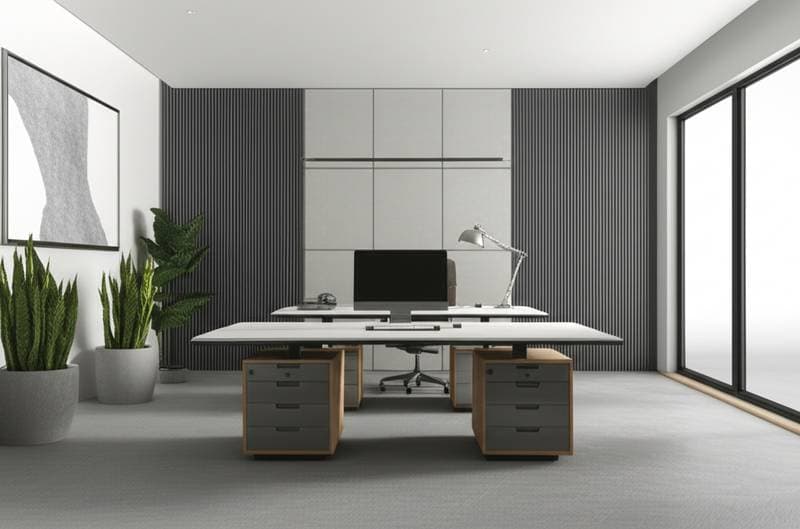Unlock 8 Percent Home Value Increase with Soundproof Offices
Home offices often face interruptions from household noises such as barking dogs or kitchen appliances during video calls. Such distractions not only hinder focus but also diminish property appeal. Modern buyers prioritize functional remote workspaces, and a soundproof office can enhance market value by approximately eight percent. This insight emerged from transforming a spare bedroom into an effective quiet zone that supports uninterrupted concentration.
Soundproofing extends beyond mere silence to encompass comfort, privacy, and substantial return on investment. Professionals working from home or pursuing side projects benefit greatly from acoustic enhancements, positioning them among the most strategic home improvements available.
Why Soundproof Offices Drive Property Value
The rise of remote work has reshaped buyer preferences for homes. A private, quiet dedicated space rivals the appeal of a modernized kitchen. Internal or external noise pollution impairs concentration, while properties addressing this issue gain a competitive edge. Real estate professionals increasingly highlight soundproof home offices as a premium feature that supports elevated pricing.
A properly insulated office improves focus and alleviates stress by establishing distinct work-life boundaries. Closing the office door enables full immersion in professional tasks, and exiting restores personal relaxation. Buyers perceive this separation as a significant lifestyle enhancement.
Decision Framework: Do-It-Yourself or Professional Assistance
Both approaches offer merits based on project scope. An initial effort involved applying acoustic foam to drywall using spray adhesive, which appeared adequate but failed to mitigate low-frequency sounds from external sources like heavy vehicles. A subsequent project engaged an insulation expert to incorporate mass-loaded vinyl, additional drywall layers, and thorough seam sealing, resulting in noticeable improvements.
When Do-It-Yourself Approaches Succeed
- Install peel-and-stick acoustic panels or heavy curtains for surface-level absorption.
- Apply weather stripping to seal door and window gaps.
- Place carpets or rugs to reduce internal echoes.
Do-it-yourself complexity ranges from low to moderate. Basic tools suffice for weekend surface modifications.
When Professional Expertise Is Essential
- Incorporate or replace drywall for structural sound barriers.
- Fit soundproof doors or double-pane windows.
- Manage electrical rerouting or heating, ventilation, and air conditioning adjustments.
Professionals must handle structural alterations or electrical work to comply with building codes and maintain fire safety standards.
Step-by-Step Soundproofing Process for Your Office
1. Assess Noise Origins
Determine sound entry points. External traffic demands distinct treatments compared to internal echoes or conversations. Employ a sound meter application or observe the room during peak noise periods to pinpoint sources.
2. Seal Visible Openings
Address apparent vulnerabilities first. Install weather stripping on doors, apply acoustic caulk to cracks, and add door sweeps. These measures prevent sound transmission through air pathways.
3. Enhance Wall Mass
Incorporate additional drywall layers or specialized soundproofing boards to boost density. Use acoustic adhesive between layers to dampen vibrations. For space constraints, position heavy bookcases or wall panels as alternatives.
4. Treat Floors and Ceilings
Sound travels readily through these surfaces. Layer thick rugs or add cork underlayment under flooring materials. Acoustic ceiling tiles or suspended panels can diminish echoes by 30 to 50 percent.
5. Improve Window Performance
Proximity to traffic warrants double-pane or laminated glass upgrades. Removable window inserts provide a cost-effective option, potentially reducing external noise by up to 70 percent.
6. Reinforce Door Insulation
Standard hollow-core interior doors offer minimal sound resistance. Replace them with solid-core variants, priced at $300 to $700 each, to achieve superior acoustic separation.
7. Evaluate and Refine
After completion, test efficacy by playing music or simulating external sounds. Target persistent leaks at corners, electrical outlets, or vents. Incremental adjustments ensure comprehensive coverage.
Pitfalls to Sidestep in Soundproofing Projects
Experience with multiple renovations underscores the importance of precision in soundproofing.
-
Neglecting Door Clearances: A one-inch gap beneath a door permits noise equivalent to an open window. Install sweeps or automatic bottoms without exception.
-
Overlooking Airflow Needs: Complete sealing risks poor ventilation, leading to humidity or thermal imbalances. Consult contractors on airflow solutions.
-
Combining Unsuitable Materials: Adhesives and panels must align with specifications. Adhere to manufacturer guidelines for compatibility.
-
Disregarding Visual Harmony: Select acoustic panels in varied colors and textures. Integrate them thoughtfully into overall room aesthetics.
-
Bypassing Expert Assessments: Complex issues like plumbing vibrations or heating, ventilation, and air conditioning resonances require acoustical engineers to analyze frequencies and recommend precise interventions.
Enduring Advantages Extending Past Valuation
A fully soundproof office elevates beyond financial metrics. It fosters a professional environment where meetings transmit clearly and sustained focus becomes routine without exhaustion. Productivity often doubles post-renovation, contributing to a more serene household dynamic.
Such modifications enhance home versatility. The space adapts easily to roles like a music room, nursery, or guest quarters, with noise containment preserving tranquility elsewhere. Buyers value this adaptability as an added asset.
Implementing Your Soundproof Office Upgrade
Prepare with this structured plan:
-
Identify primary noise contributors through targeted assessment.
-
Establish a budget between $3,500 and $8,000, accounting for materials and labor.
-
Allocate do-it-yourself tasks versus professional services.
-
Source supplies in advance to prevent delays.
-
Time installations for off-peak seasons to secure favorable rates.
-
Conduct final inspections to address any remaining vulnerabilities.
Soundproofing a home office delivers immediate usability gains alongside enduring property appreciation. It positions the residence favorably for prospective purchasers while optimizing current work efficiency.



